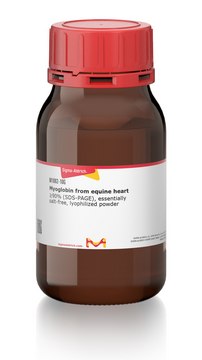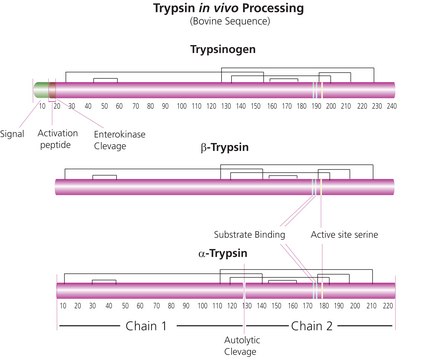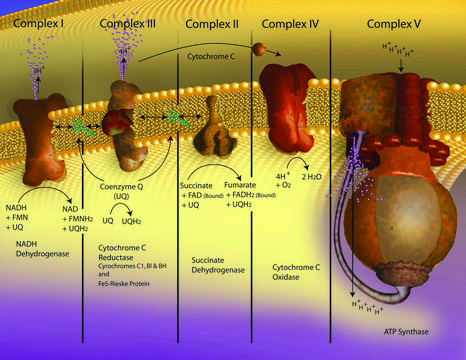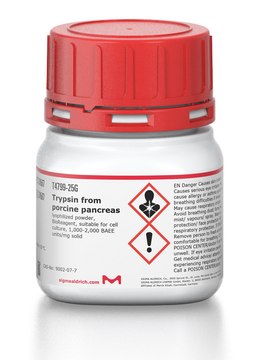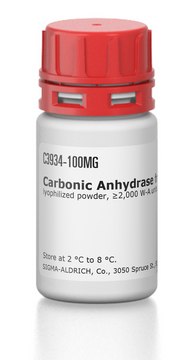T1143
Trypsinogen from bovine pancreas
essentially salt-free, lyophilized powder, ≥10,000 BAEE units/mg protein (E1%/280, after activation to trypsin)
Sign Into View Organizational & Contract Pricing
All Photos(1)
About This Item
Recommended Products
biological source
bovine pancreas
Quality Level
Assay
85-100% (UV)
form
essentially salt-free, lyophilized powder
specific activity
≥10,000 BAEE units/mg protein (E1%/280, after activation to trypsin)
mol wt
23,981 Da by calculation
technique(s)
mass spectrometry (MS): suitable
solubility
H2O: soluble 10 mg/mL
UniProt accession no.
storage temp.
−20°C
Gene Information
bovine ... TRYP8(282603)
Looking for similar products? Visit Product Comparison Guide
General description
Trypsinogen is a proenzyme (zymogen) that is activated to form trypsin. It is synthesized in the pancreas and activated by enterokinase once it reaches the lumen of the small intestine. Bovine trypsinogen is a single polypeptide chain of 229 amino acids that is cross linked by six disulfide bridges. Enterokinase cleaves a hexapeptide to from the NH2 terminus of trypsinogen at the Lys6 - Ile7 peptide bond and activates it. Trypsin, thus formed, autocatalytically activates more trypsinogen to trypsin. This native form of trypsin is called β-trypsin, which undergoes autolysis at Lys131 - Ser132 resulting in α-trypsin that is held together by disulfide bridges. Trypsin is a serine protease with His46 and Ser183 at the active site. The pH optimum of trypsin is 7 - 9.
Application
Trypsinogen from bovine pancreas is suitable for use in:
- the secondary structure analysis of proteins in H2O solution using single-pass attenuated total reflection Fourier transform infrared (ATR-FT-IR) microscopy
- tuning and calibration of electrospray ionization quadrupole time-of-flight (ESI-Q-TOF) mass spectrometer
- the secondary structure analysis of proteins by infrared (IR) spectroscopy
- SDS-PAGE as a molecular weight standard (24kDa)
Biochem/physiol Actions
Phytic acid complexed with calcium has been shown to increase the secretion of trypsinogen unable to be cleaved for activation. It also reduced the stabilization effect of calcium on activated trypsin. The active form of trypsinogen, referred to as trypsin, cleaves peptides on the C-terminal side of lysine and arginine amino acid residues. It also hydrolyzes ester and amide linkages of synthetic derivatives of amino acids such as, benzoyl L-arginine ethyl ester (BAEE), p-toluenesulfonyl-L-arginine methyl ester (TAME), etc.
Unit Definition
One BAEE unit is equal to a ΔA253 of 0.001 per min with BAEE as substrate at pH 7.6 at 25 °C and a reaction volume of 3.2 mL (1 cm light path).
Signal Word
Danger
Hazard Statements
Precautionary Statements
Hazard Classifications
Eye Irrit. 2 - Resp. Sens. 1 - Skin Irrit. 2
Storage Class Code
11 - Combustible Solids
WGK
WGK 1
Flash Point(F)
Not applicable
Flash Point(C)
Not applicable
Personal Protective Equipment
dust mask type N95 (US), Eyeshields, Gloves
Choose from one of the most recent versions:
Already Own This Product?
Find documentation for the products that you have recently purchased in the Document Library.
Customers Also Viewed
Our team of scientists has experience in all areas of research including Life Science, Material Science, Chemical Synthesis, Chromatography, Analytical and many others.
Contact Technical Service